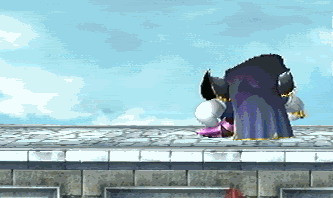Interruptibility is the ability to begin a new action even though the current action's animation has not yet finished. For example, while Mario's forward smash in Super Smash Bros. Brawl takes 56 frames to complete execution, the player can interrupt the ending frames and do something else as early as frame 48. For most intents and purposes, this results in the last part of the animation simply being filler, as the player is likely to attack, jump, or simply move as soon as possible. Many attacks have a minor amount of interruptible frames during their ending lag, while in general special moves and get-up animations do not; some attacks such as Marth's or Ness's down tilts have a significant interruptibility window which allows them to follow up the attack much faster than the animation would suggest.
In Super Smash Bros., interruptibility is not very common, only being used at the ends of some taunts and non-final neutral attacks. Super Smash Bros. Melee expanded interruptibility's applications to many attacks, and Brawl continued the idea as a common mechanic.
It is possible for actions to be interruptible with only certain kinds of actions, such as the case with jump cancelling. In Melee, aerials cannot be cancelled with air dodges, while they can be in Brawl onwards. Most grounded moves (such as most down tilts) can be interrupted with a dash, jump, or other attacks, but not with some combination of shielding, walking, or turning around. A character stuck in the animation of their aerial or air dodge will not be able to grab the ledge until it is completely finished, regardless if it can be interrupted much earlier. This is most prominent with Sheik's forward aerial.
In Smash 64 and Melee, interrupting a delayed double jump results in double jump cancelling. This is no longer possible from Brawl onwards, as doing so only interrupts the animation of the double jump, not the execution.
Trivia
- An older name for the concept of interruptibility is "interruptible as soon as frames", or "IASA frames", under the premise of describing them with "the attack can be interrupted as soon as frame X". As technical research into Brawl progressed, the term began falling out of favour due to its wordiness and the implication that it is a property of the frames, when in fact it is a property of the move as a whole. It has since resurfaced along with a slightly more precise term, "FAF" ("first actionable frame").
- Most other fighting games feature interruptibility, but extra frames are used for the sole purpose of making attack animations less choppy if performed by themselves, and are not as useful for throwing opponents off with deceptively fast moves. These extra frames are also not subject to any restrictions like moves in the Super Smash Bros. series are.
- Shulk is the only character who can interrupt all aerials with another input during their ending frames, which allows him to act out of his ending-lag heavy aerials.

